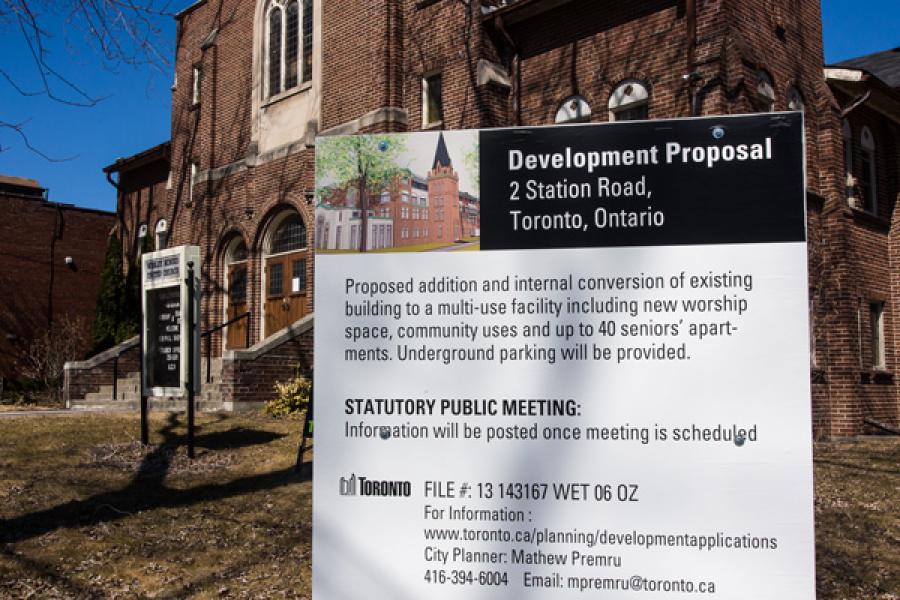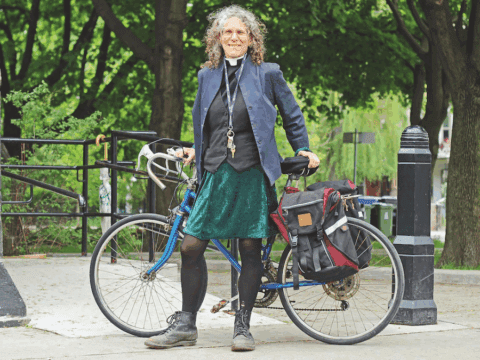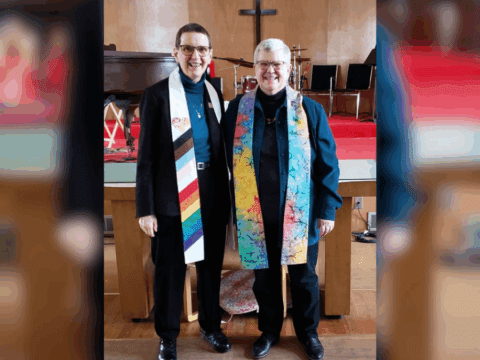Optimism is bubbling at St. Stephen United as an early-winter service slides into lunch in the annex, and church trustees join Rev. Allison Playfair at a table to discuss the days ahead. In a near unanimous vote, the 120-person congregation in suburban Burlington, Ont., has just endorsed a plan to enter the real estate game and redevelop its property, perhaps even to tear down its familiar old home and replace it with something smaller — or not, as the market may dictate.
Suddenly, everything is up in the air. The congregation’s future, once merely questionable, is now a blank. But it is excitement rather than fear that sets the mood at lunch. Having watched helplessly as attendance dropped off, reserves drained and repair costs mounted, the trustees responded with a bold initiative for renewal. And the congregation has just backed them by a vote of 81 to three.
“I love that this community has decided to move forward in this direction to expand its mission,” says Playfair. “This is not, ‘Save the sinking ship.’ This is, ‘Hey, we need to change the vehicle we are using to fulfil God’s mission.’”
The United Church is closing congregations at a rate of more than one a week. Dozens, maybe hundreds, of pastoral charges are wondering what comes next. In an Observer readership survey conducted last year, close to half of respondents said their congregation’s membership is shrinking, and a third believed that by 2025, their congregation probably wouldn’t still be using its current building. The findings suggest that more and more people in the United Church are like the congregants at St. Stephen: considering using their often-crumbling urban real estate to leverage new ways of being a church. They’re discovering that soul-searching is the easy part. It’s in the follow-through that the going can get rough.
“If we left things the way they are, we would sink,” says Paul Bartu, chair of trustees at St. Stephen. Playfair agrees. In fact, what excites and unites everyone today is the fact that almost nobody at St. Stephen is content to leave things the way they are — they want to turn decline into opportunity.
For the moment, that’s as far as they’ve got. The job now is to decide which option to pursue. According to church volunteer Heather McGavin, a real estate consultant has already told them a 120-unit condo building on the site could earn them enough to rebuild their church and maintain it for 99 years. He has also warned them strongly against using the word “affordable” in connection with any housing they might want to build on the site.
“It’s a bit of a tap dance,” says McGavin, who is leading St. Stephen’s visioning process. “We want to do something in an outreach capacity, but we know we need to make a viable income to do that outreach. So we’re just taking it one step at a time.”
“It’s in service to others that we grow spiritually,” says Playfair. “I firmly believe that. So in another 10 years, this congregation is going to be in an even deeper relationship with God because of this work.”

St. Stephen seems to be heeding the cardinal rule of repurposing: go into it with your eyes open. Even a plan conceived with the best of intentions can go horribly wrong. Just ask Rev. Nick Trussell of Edmonton.
Trussell is the Anglican priest at Holy Trinity Riverbend Anglican Church. He remembers a great upwelling of faith that accompanied his small congregation’s decision to forgo a potentially advantageous real estate deal — one he personally favoured — and instead to donate its surplus property for use as supportive housing for homeless people. “There’s no doubt it was the right thing to do,” says the young priest, “and I was really inspired by the faith of the congregation when they decided to do that.”
But as none know better than Trussell, his congregation’s leap of faith landed in a vale of tears. Fear ran riot in Terwillegar Towne, a massive new housing tract that surrounds Holy Trinity, amplified by social media and documented on the nightly news through a series of increasingly rancorous community meetings. The situation came to a head last July, when vandals painted “No homeless” in large letters across the front of the little church. Shortly thereafter, Edmonton Bishop Jane Alexander “pulled the Band-Aid off,” according to Trussell, and cancelled the project.
All that survives is a trace of the graffiti visible under a fresh coat of paint, applied by order of the city. Trussell would have preferred to let it be, and the message is certainly valid: there are no homeless here.
“We certainly began to hear and live the Gospel in a different way,” Trussell notes ironically, recalling the rage that beset his congregants when they set out to do the right thing. But no, there was little positive about the effort. “It was, in fact, a really, really challenging experience,” he adds, one the faith that inspired it barely survived.
But as an object lesson for other churches in other Canadian cities, especially the many that are now seeking renewal through rebuilding, the tragedy of Terwillegar Towne could not be bettered. What began as an exercise in Christian generosity ended in a hard collision at the absolute limit of modern Canada’s tolerance for social mission anywhere near its backyard.
And it is just one of many similar examples. After working for seven years on a project to replace their crumbling church with housing for seniors, the parishioners at St. John’s United in Halifax were devastated when the municipality, backed by local politicians and the church’s neighbours, soundly rejected their plan last summer. The church has gone back to the drawing board to try to revive it. Five years of intensive planning has yet to yield much progress in a similar initiative to redevelop Wesley Mimico United in suburban Toronto, likewise stalled in the face of community opposition. For every congregation that sets out on a mission of renewal through real estate, it seems another founders on the hidden reefs of 21st-century reality.
The mounting casualties have not gone unnoticed by church officials, who are responding with a variety of processes to help congregations navigate the perils of redevelopment. The congregation at St. Stephen in Burlington is getting assistance from a new formalized process devised by the EDGE Network for innovative ministry, based in the United Church’s General Council Office in Toronto. EDGE consultant Carla Langhorst describes the program as “a one-stop shop where you can get support for all your property options.” By establishing a set of best practices to ensure congregations don’t repeat one another’s mistakes, Langhorst says, the church can help lower the average time it takes to redevelop a surplus property from five years to one year or less.
In western Canada, persistent calls for help from foundering congregations led the United Church’s British Columbia Conference to develop an innovative process of “bundling” several different, widely separated surplus properties for redevelopment by a single commercial operator.
As urban churches age past the point of repair, the market beckons and consultants proliferate. A new, less sentimental attitude toward built heritage and neighbourhood traditions — up to and including the outright rejection of any social purpose beyond mere survival — is taking hold. Good stewardship requires sharp deal-making — that’s the consultants’ mantra.
“These are market solutions,” says Terry Harrison, head of the B.C. Conference’s property resource team, speaking about her group’s unapologetically commercial strategy. “We’re not setting out to build social housing. Social housing costs money. We’re setting out to renew these congregations by rebuilding their physical space and providing them with an ongoing source of cash proceeds.”
In short, she adds, “There’s dollars in that dirt.”
Even United Church Moderator Rt. Rev. Gary Paterson seemed to tilt toward the more hard-headed view during a January visit to Edmonton, where downtown landmark McDougall United, home of the first Protestant congregation in Alberta, is struggling to survive. City council had just rejected a proposal from McDougall to buy the property for $1, invest the millions needed to restore it and continue to let the congregation use the church — along with the many other groups that currently call the building home.
“We actually don’t need all these church buildings in order to have a vibrant expression of church and of faith,” Paterson told the Edmonton Journal. “A building can be both a bane and a blessing” — and crumbling McDougall looks like a bane. “Maybe not necessarily, but I would not be heartsick if it disappeared,” the Journal reported Paterson as saying.
Such an approach is by no means natural to the majority of United Church congregations, as Ontario real estate consultant Michael Wright, contracted by EDGE to advise St. Stephen and others, has discovered. “They have a lot of trouble dealing with that ‘for profit’ idea,” he says, adding that his biggest challenge is to persuade church members to see their properties not as sacred places but as financial engines capable of creating what is very often “substantial revenue.”
“There’s a lot of fear around the fact that we might be making some money instead of losing it,” Wright says. “It’s very unique.” And as the fate of many stubbornly altruistic church redevelopment projects attests, it’s almost infinitely problematic.
Despite its styling as a quaint, “neo-traditional” community, Terwillegar Towne is an enormous, industrial-strength suburb of the most modern type. It’s an impressive monument to the good life in fast-rising Alberta, expressed incongruously as a vinyl-sided echo of Olde New England on the prairie in southwestern Edmonton — and scaled to house more than 20,000 people in a single gulp. The instant neighbourhood where he ministers is more populous than the 230-year-old city where he grew up, notes Nick Trussell, a native of Brockville, Ont.
Terwillegar Towne has an architectural code and a residents’ association to which all homeowners pay compulsory dues. It even has a logo featuring the image of a church steeple, a perfect metaphor for the traditional values the community promotes — as well as being the prime emblem of its contradictions.
As it happens, there are no real steeples in Terwillegar Towne. Its allegedly traditional master plan made room for only one small “community church” to serve a small city that, were it actually traditional, would be studded with dozens of steeples, most in a state of disrepair.
Holy Trinity Riverbend is just as new as Terwillegar Towne but emphatically not part of it. It was built on an unimproved road running beside the tract just outside its official boundary, with the open prairie at its back and next door to the four 80-unit condominium buildings that constitute the tract’s required allotment of affordable housing — housing that developers are obligated to build but typically shove to the margins of their projects along with churches.
The congregation discovered just how isolated it was when it naively embraced a proposal for a 60-unit building to house and support former street people on land it owned just north of the church. The plan was ambitious, but all the stars seemed aligned: the Edmonton diocese was keen to fulfil a commitment it had made to end homelessness as part of an interfaith agreement signed by 23 local religious leaders; the project was in the hands of an experienced operator equipped with $12 million in grants from the provincial and federal governments; popular Edmonton Mayor Stephen Mandel supported it, along with local MLA Dave Hancock, who was the Alberta cabinet minister responsible for social housing (he’s since become premier following Alison Redford’s resignation); and finally, the land was already zoned for social housing — city council couldn’t have said no even if it wanted to.
Every possible permission was in place, all carefully assembled and fitted into a perfect political suicide vest.
Trussell is a gentle soul who had never even heard the word “NIMBY” (not in my backyard) before he became the target of one of the fiercest outbreaks ever recorded in Canada, the vandalism of his church accompanied by threats of violence against him personally. Leading the battle against the project was a neighbourhood activist who doubled as a Baptist minister. The arguments were numerous — some legitimate, some mere pretexts to mask a basic urge to exclude — but it was venom that set the tone. Holy Trinity congregants were shunned, play dates cancelled and houses put up for sale as Twitter and Facebook fanned the hysteria.
“It just went really deep, really quickly,” Edmonton Bishop Jane Alexander says, “and I think everybody was horrified at what happened.” The debate was an “eye-opener,” she admits, the low point a raucous public meeting in August.
“I was quite shocked to hear what people said,” says the bishop, a not-unworldly Briton who immigrated to Edmonton two decades ago. “I thought, ‘Oh my gosh, if your children heard you speaking like that, would that be a good thing?’ It just really shocked me that people could say such dreadful, dreadful things.”
Voices of reason were not absent: in attendance to support the project, Mayor Mandel warned the crowd against NIMBYism and was met with angry shouts demanding he apologize. He refused, according to Trussell. Both Trussell and Alexander fondly recall the few brave souls who spoke up in support of the project. But in the end the church backed down.
“You hope they don’t feel that you let them down, but I’m sure that they do,” Alexander says. “I’m sure they feel that we bailed.”
Many factors influenced the retreat — it was all but unavoidable — and like all generals, Alexander vows to return to the same ground with what she and Trussell hope will be a more acceptable proposal. But until they do, she acknowledges, the bullies have won. There’s still no room for lost sheep in master-planned Terwillegar Towne.
Stephen Mandel, now retired after three terms as Edmonton mayor, lays no blame for the calamity on the constituents who shouted him down for supporting the project. The shouters do not represent the community he knows so well, according to Mandel, who attained his reputation as one of Canada’s most progressive urban leaders in one of its most conservative cities. The real problem was the process.
As Mandel sees it, the church’s mistake was to use mandated community consultations to present what was in effect a fait accompli. “It should be the reverse,” he says. Proponents should begin their efforts by approaching community leaders and saying, “We’re trying to help people. What’s the best way to help them to make sure they’re successful?”
Had it started smaller and progressed more slowly, the project could have succeeded, Mandel says. And Terwillegar Towne is no different from any other neighbourhood in his city. “There’s social problems everywhere,” he says. “It’s not like these neighbourhoods are free from issues. But you need to do a better job of explaining and selling if you’re doing the kind of thing they were trying to do in Terwillegar.”
Every expert agrees that community outreach is key to the success of any church redevelopment project, if only because that is where churches so often fail — in the very sort of work they were founded to undertake. Thus the final irony of the Terwillegar tale: among churches seeking to reach out through redevelopment, the logic of benevolence can sometimes become as mulish — and unproductive — as NIMBY.
“You’ve got to engage your community before you do anything else,” says Rev. Joel Den Haan, a consultant and former United Church staffperson who has helped guide a number of Alberta United Church congregations through the hazards of redevelopment. “You’ve got to bring them along in the process, and you have to hear what their interests are.
“If the community comes back and says, ‘We don’t want these ugly seniors cluttering the sidewalks with their walkers,’ then you’ve got to say, ‘What would it take to bring you into this in a constructive fashion?’”
And if the seniors or poor people remain anathema, you must be prepared to move on, Den Haan advises. “I’d be inclined to say, ‘Okay then, sell your property, carry it over and let’s do a joint venture somewhere else where the environment is a little bit easier.’” Too often, he adds, good intentions yield terrible deals.
Nothing but the best, most thoughtful intentions grace the website of Spirit Place, the name of the new multi-purpose facility with which the parishioners of St. John’s United in Halifax hope to replace their aging red brick church. The site brims with good faith and hope for a new building that will combine “an inspiring place to worship” with “a variety of outreach programs and services” and no fewer than 59 apartments for senior citizens, “including seniors of the gay, lesbian, bisexual and transgendered (GLBT) community.”
The process of creating Spirit Place “has been one of openness, exploration, discovery, respect, and engagement,” the website says. The result: “Good for the Community!”
But its immediate neighbours in peninsular Halifax haven’t seen it that way. They adamantly opposed the proposal, which envisaged a building that was twice the height and twice the density allowed by existing zoning in the low-rise residential neighbourhood. Last summer, the Halifax Regional Municipality rejected the church’s application, bringing a sad end to several years of faith, hope and hard work.
The church subsequently entered into a formal process under a professional mediator to negotiate with its neighbours. “But it has been a challenge to find common ground,” church volunteer Louisa Horne admits.
Nobody has objected to the proposed use of the land or the social ideals behind it. “It’s just too big,” says one neighbour, who asked not to be identified. Looking at the renderings of the building originally submitted for city approval, it’s hard to disagree.
Spirit Place grew outsized because of a financial equation whose terms were dictated by perhaps too many good intentions. Keeping the apartments both affordable and capable of generating sufficient income to subsidize the rest of the project (including a new worship space) required far more units than the zoning permits.
St. John’s is now proceeding with a new plan for a building that Horne says will have “quite a bit less mass.” On-again, off-again negotiations with neighbours concluded earlier this year. Talks with the city resumed in April as the church prepared to enter the approvals fray once again.
You haven’t seen the worst yet,” Rev. Harry Oussoren warns as he carefully descends a narrow staircase into the musty darkness of the basement beneath Wesley Mimico United in Toronto. “Watch your step.” The smell of rust and mould rises up from a half-lit netherworld where corroded pipes leak greasy puddles onto a broken tile floor. Leftover artifacts of a once-vibrant community life punctuate the gloom. “It’s a very sad picture, really,” says Oussoren, a retired former official with the General Council and Wesley Mimico’s interim minister.
It’s also “the typical story of the average United Church,” he adds — once thrumming, now quietly going the way of all brick, mortar and wood, with a much smaller, older congregation and 21 hard-to-negotiate steps leading from the sidewalk up to the sanctuary.
And typical, too, in the difficulties the congregation has encountered in its struggle to rebuild. In the plan that emerged after much soul-searching, life-lease seniors’ apartments would occupy what is now the sanctuary, which becomes much smaller and more accessible, while most of the church’s exterior, including its signature corner tower, would remain intact.
Neighbours responded by launching a vigorous “Save Wesley Mimico” campaign. That was five years ago.
“And every month costs us several thousand dollars, all of which is money we had to borrow,” Oussoren says. “So it’s a charge against the development, and there’s no certainty whatsoever that we will succeed. It could be failure and a loss of equity on the order of a couple hundred thousand dollars.”
Suspicion about the prospective tenants ran rampant, as it did in Terwillegar Towne, even though the apartments were never intended to be especially affordable. “We have never stated that we had a social mission,” Oussoren says. “We don’t have the resources to do that. All we’re trying to do is to repurpose the place so that there’s room for three things: the congregation, community programs and housing for middle-class seniors who want to stay in the community.”
Nonetheless, intolerance ran high. “The people in rental accommodation are assumed to be ne’er-do-wells,” Oussoren says. “The reality is that some of those people have been here for 30 years, and this is their community.”
Municipal demands and delays have been equally challenging, Oussoren adds, pointing to an upper corner of the new building that city planners would like to see lopped off to reduce its bulk. “We would lose 2,000 square feet. That’s a million dollars,” he says. The church submitted its application for redevelopment in April 2013. A year later, it still awaits an official response.
But no number of delays and difficulties would ever induce the congregation to sell out and move on, even if that meant more money for a new church in an “easier” environment. Despite all the other compromises and concessions, Oussoren says, the congregation’s continued existence in Mimico is non-negotiable. “To not be present in the community just seems irresponsible.”
Parishioners are worried about the future of the project, Oussoren admits. “On the other hand, we know that if we weren’t risking now, we would be going downhill and dying probably. And so we would rather risk the whole thing.” Their attitude is the same one that currently animates St. Stephen in Burlington and many other churches as they embark on the same path. What’s impressive in Mimico is how hardy it remains after five years of difficulty and disappointment.
Therein lies the moral: “Death and resurrection is a very strong theme in the Christian religion,” Oussoren says. “So we can gradually slide into death, or we can risk death in order to rise. That’s what this congregation is trying to do.”















